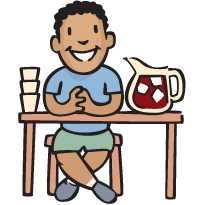Boston Children's Museum
308 Congress Street, Boston, MA 02210
617-426-6500
© Boston Children’s Museum 2025
Website Design by JackrabbitCooking activities, even simple ones like this, are filled with great learning opportunities. Along with measurement and math skills, kids can develop problem solving and literacy skills as well. Also, by showing kids that they can make tasty drinks that are much more healthful than store-bought soda, you will provide an opportunity to talk about making healthy choices in their diets.
This activity is the first in a series of Soda Science activities. Try the others after doing this one.

Ask your students to name some of their favorite flavors of soda. Write these soda names/flavors on a piece of chart paper or chalkboard. There are a lot of flavors! How did people come up with these flavors? Have any of your students ever made up a recipe at home before? What did they make? Was it great the first time, or is there anything they’d change about the recipe to make it better?
Can you invent a new flavor of soda?
After 10-15 minutes, stop your students and bring them together to share their observations with each other. How are they measuring their sugar? Look for a discussion about “leveling off” the spoonfuls so that the measurement is consistent. Does the food coloring make a difference in the taste of the drink? Can they make changes to their recipes to make them even better? Would they like to try a whole new recipe? This discussion should last no more than 5-10 minutes.
After the discussion, have your students go back to their teams and try to perfect their recipes, or try all new ones. This first session is all about messing around and trying different flavors – the second session should be more focused on choosing one recipe and perfecting it.